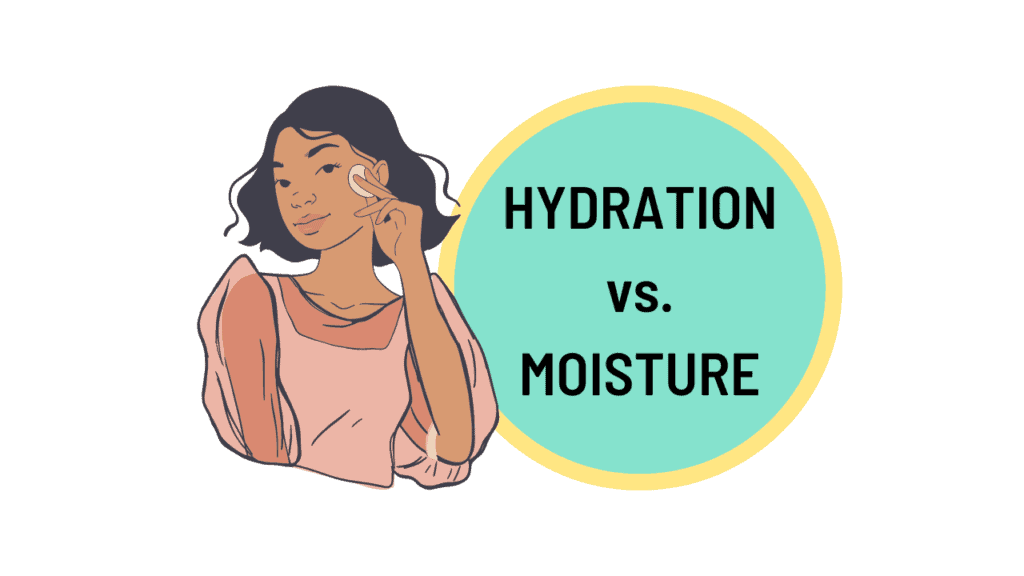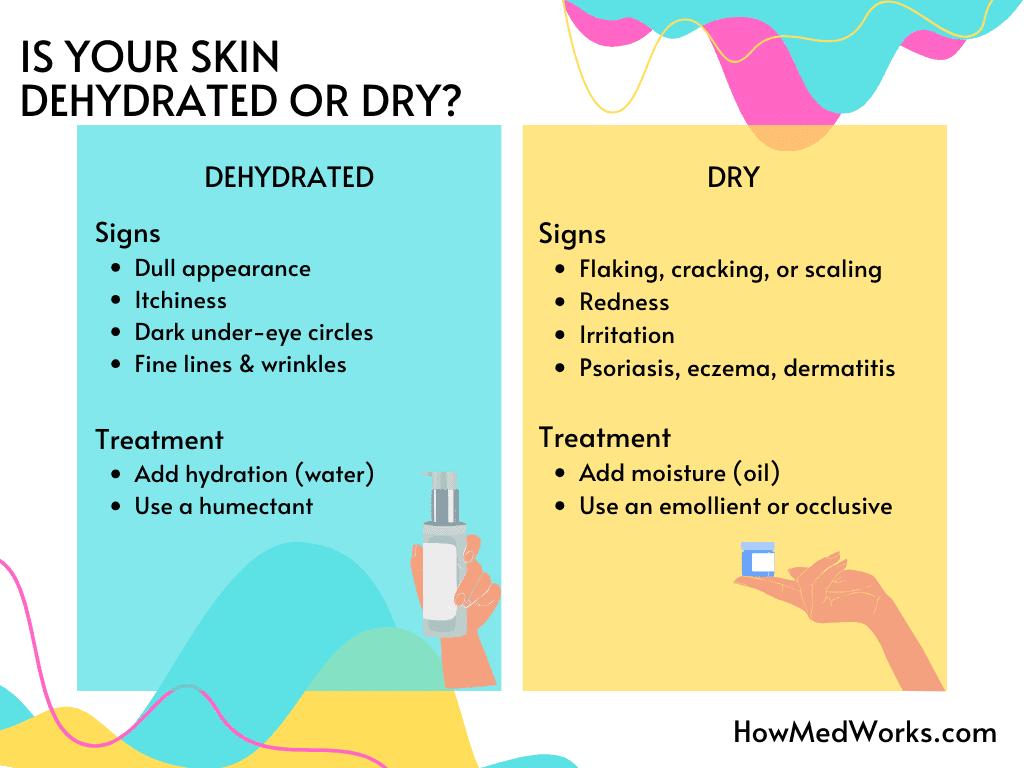
Moisturizers and face creams everywhere are plastered with words like “super hydrating” and “ultra-moisturizing.” They sound similar enough, but did you know that there’s actually a huge difference? Hydration and moisture are two skincare terms that are often used interchangeably, but they are, in fact, very different.
In this article, I’ll be going over the difference between hydration and moisture, as well as how you can determine which one you need. I’ll also give you my top tips and tricks to use when looking for the right skincare products so you can shop skincare like a pro. Keep reading! 😀
Table of Contents
What Is Hydration?
Hydration relates to the water content of the skin. Skin that has sufficient water is “hydrated,” while skin that lacks a sufficient amount of water is “dehydrated.” Dehydrated skin occurs when the rate at which your skin is losing water is greater than the rate at which you’re adding water.
Water content in skin is affected by both internal and external factors. Dehydrated skin can be due to a number of reasons, including:
- Not drinking enough water
- Dry weather
- Air conditioning

- Hot showers
Correspondingly, you should use a hydrating product if your skin lacks sufficient water. One category of hydrating products is humectants. A humectant is a substance that draws water. By applying a humectant, water is pulled from the environment into your skin, giving hydration. Some examples of humectants are glycerin
By applying a humectant, water is pulled from the environment into your skin, giving hydration. Some examples of humectants are glycerin , hyaluronic acid
, hyaluronic acid , and polyglutamic acid
, and polyglutamic acid so the next time you’re looking for a hydrating skincare product, check the ingredients list to see if it includes one of these.
so the next time you’re looking for a hydrating skincare product, check the ingredients list to see if it includes one of these.
What Is Moisture?
Moisture pertains to the oil content of the skin. Skin that has sufficient oil is “moisturized,” and skin that lacks a sufficient amount of oil is “dry.” Dry skin happens when the rate at which your skin is losing oil is greater than the rate at which oil is being produced or added.
Oil levels in the skin are also affected by internal and external factors. Dry skin can be caused by a number of things, such as:
- Naturally low oil production
- Hot weather

- Using harsh soaps
- Not using a moisturizer
Accordingly, you should use a moisturizing product if your skin lacks sufficient oil. Emollients and occlusives are a great way to moisturize your skin. Emollients are components of moisturizers that add good oils back into your skin , and occlusives are emollients with high oil content that create a barrier on top of the skin, preventing water loss
, and occlusives are emollients with high oil content that create a barrier on top of the skin, preventing water loss . Some examples of emollients and occlusives include petrolatum, lanolin, waxes, and oils. The next time you’re in the market for a moisturizing skincare product, be sure to keep an eye out for these ingredients.
. Some examples of emollients and occlusives include petrolatum, lanolin, waxes, and oils. The next time you’re in the market for a moisturizing skincare product, be sure to keep an eye out for these ingredients.
Bonus Info: Oily skin is also an issue for a lot of people. Some of the most common reasons for having oily skin are genetics, fluctuating hormone levels, and overwashing the skin.
If you’re interested in learning more about oily skin and acne in particular, make sure to check out my series on types and causes of acne
, teen versus adult acne
, and over-the-counter versus prescription acne treatments
! 🙂
What Is the Difference Between Hydration and Moisture?
Simply put, hydration is associated with water, while moisture is related to oil.
To summarize, here’s a table outlining the main differences between hydration and moisture that you should know when it comes to skincare:

It’s entirely possible for skin to be moisturized (produce sufficient amounts of oil) but lack hydration (water). The term “combination skin” refers to this phenomenon, where oily skin is dehydrated, causing some areas to appear oily and others to appear dry.
How Do I Know If My Skin Needs Hydration or Moisture?
Whether someone’s skin is hydrated or dehydrated often depends on the environment. If you live somewhere dry, then you’ll likely need more hydration. If you live somewhere humid, you’ll probably require less hydration.
Contrastingly, whether someone has oily or dry skin is usually determined by natural oil production levels. If you have dry skin, you’ll probably need more moisturization. If you have oily skin, you’ll likely require less moisturization.
How Can I Tell If a Skincare Product Is Hydrating or Moisturizing?
Besides looking at the ingredient list, one way to tell if a product is hydrating or moisturizing is by checking the consistency. Gel-like products tend to be hydrating, while cream-like products are usually moisturizing.
Pro Tip: A lot of skincare brands use the terms “hydrating” and “moisturizing” interchangeably. Instead of only looking at which term they use on the packaging or in the description, check to see if the product has a thinner, gel-like consistency or thicker, cream-like consistency.
If you’re unable to see or test the product out prior to purchasing, you can look at the product description to see if the product was made for oily or dry skin. Typically, products made for oily skin (has oil, lacks water) are hydrating, and products designed for dry skin (has water, lacks oil) are moisturizing.
The Correct Way to Layer Skincare Products
After cleansing your face, you should layer skincare products from thinnest to thickest consistency. The reason behind this is that thinner products tend to have a higher concentration of water, while thicker products tend to have a higher concentration of oil. By applying thinner, water-based products first, water is able to absorb into the skin, adding hydration. Afterwards, applying a thicker, oil-heavy product will create a seal and trap water.
Layering skincare products in the opposite order – from thickest to thinnest consistency – will produce poor results. Adding thicker, oil-based products first will not only not hydrate the skin but also prevent water from penetrating. Any thinner, water-based products added on top won’t be absorbed into the skin and will evaporate.
Do I Still Need to Hydrate and Moisturize If I Have Oily Skin?
Though it may seem counterintuitive, it’s crucial to keep oily, acne-prone skin well-hydrated and moisturized. Failing to do so may cause your skin’s sebaceous glands to overcompensate and produce even more oil, which can lead to acne. To avoid this vicious cycle, make sure to wash with a gentle cleanser, add water with a hydrating product, and seal everything in with a light moisturizer.
Pro Tip: If you have more oily skin, it’s usually better to go with a gel “moisturizer.” If you have drier skin, then you should opt for a cream moisturizer. Both formulations are water-based. However, gel formulas are typically oil-free, whereas cream formulas tend to contain some oil.
You should almost always try to prevent water in the skin from evaporating by using a moisturizing product. For some individuals with very oily skin however, hydration alone may be enough, as their skin already produces enough oil naturally.
Conclusion
Great job on finishing this article! Now you’re an expert on all things hydration- and moisture-related when it comes to skincare. Feel free to show your friends and family all that you’ve learned so they can achieve their best skin as well!
If you’re interested in other articles on skincare, check out my acne series! Part 1 goes over types of acne and their causes, Part 2
goes over types of acne and their causes, Part 2 talks about the differences between teen and adult acne in particular, and Part 3
talks about the differences between teen and adult acne in particular, and Part 3 includes a comprehensive list on over-the-counter and prescription acne treatments. See you in my next article! Stay safe and keep learning. 😀
includes a comprehensive list on over-the-counter and prescription acne treatments. See you in my next article! Stay safe and keep learning. 😀
